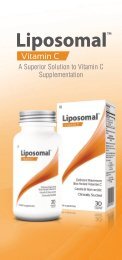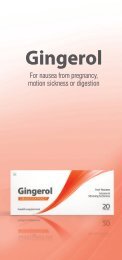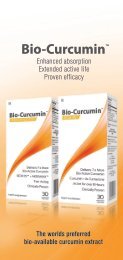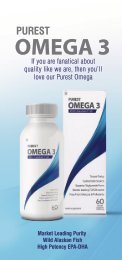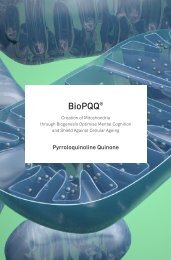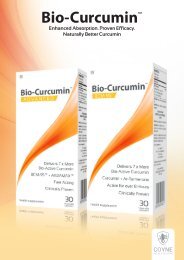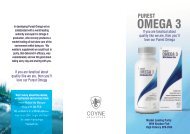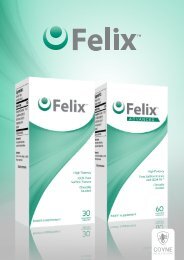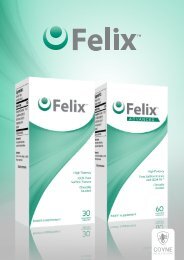BioMaxCoQ10 Professional detailer CoyneHealthcare1701026_DetailAid_Bio-Max-Web
Create successful ePaper yourself
Turn your PDF publications into a flip-book with our unique Google optimized e-Paper software.
<strong>Bio</strong>max <br />
MicroActive ® CoQ10
Product Information For <strong>Bio</strong>max® Co-Enzyme Q10<br />
Proprietary name<br />
Product composition<br />
Product specifications<br />
Ingredient source<br />
Pharmacological action<br />
Indications<br />
Contraindications<br />
Medicinal interactions<br />
Interactions with diseases or conditions<br />
Pregnancy and breastfeeding<br />
Warnings<br />
Dosage and directions for use<br />
Known symptoms of overdose and particulars of its treatment<br />
Identification<br />
Presentation<br />
Storage conditions
What is Co-Enzyme Q10?<br />
Co-Enzyme Q10 is a fat-soluble vitamin-like compound. It is also known as ubiquinone,<br />
ubidecarenone, coenzyme Q and sometimes abbreviated to CoQ10, CoQ, Q10. It is found in almost<br />
every eukaryotic cell of the body, primarily in the mithochondria. It is a component of the electron<br />
transport chain and therefore participates in aerobic cellular respiration which is responsible for<br />
generating energy in the form of adenosine triphosphate (ATP). More than 75 percent of the body’s<br />
energy is produced this way.<br />
The highest concentrations of Co-Enzyme Q10 are found in those organs with the highest energy<br />
requirements, such as the heart, liver, kidneys and pancreas. CoQ10 is concentrated in these organs<br />
because it is essential to the process of producing cellular energy from the food you eat.<br />
The other functions of Co-Enzyme Q10 include activity as an antioxidant, a membrane stabilizer,<br />
and as a cofactor in many metabolic pathways.<br />
Distribution in the Body<br />
CoQ10 is made naturally in the body, but deficiency may occur due to disease, low dietary intake,<br />
The concentration of Coenzyme Q10 in the body decreases<br />
year by year, indicating that it has a close relationship with aging.<br />
the use of certain medications or high CoQ10 use by the body. The concentration of CoQ10 in the<br />
body decreases year by year suggesting a relationship with aging and the related risk of deficiency.<br />
100%<br />
CoQ10<br />
Levels 100% 95.3%<br />
83%<br />
Liver<br />
72.6%<br />
68.2%<br />
Lungs<br />
Kidneys<br />
65.3%<br />
51.7%<br />
Heart<br />
42.9%<br />
20 Years 40 Years 60 Years 80 Years<br />
Distribution in the body<br />
The concentration of Coenzyme Q10 in the body decreases<br />
year by year, indicating that it has a close relationship with aging
Symptoms of deficiency include<br />
• Loss of muscle control<br />
• Cardiomyopathy<br />
• Muscle weakness<br />
• Cerebellar atrophy<br />
• Physical and mental fatigue<br />
• Seizures<br />
• Chronic pain / headaches<br />
• Low mood<br />
Patient’s at risk of CoQ10 deficiency<br />
• Over the age of 30<br />
• The use of certain chronic medications<br />
• Neuromuscular disease<br />
• Neurological disease<br />
• Cardiovascular disease<br />
• IBS, Crohn’s disease, celiac disease<br />
• Chronic fatigue syndrome<br />
• Fibromyalgia<br />
• Overweight<br />
Medications causing deficiency include<br />
Anti-hypertensive<br />
Medications<br />
• Beta Blockers<br />
• Thiazide<br />
• Hydralazine<br />
• Methyldopa<br />
• Clonidine<br />
Cholesterol Lowering<br />
Medications<br />
• Gemfibrozil<br />
• Statin Drugs/HMG-CoA<br />
Reductase inhibitors<br />
Anti-Psychotic/Anti-<br />
Depressant Medications<br />
• Haloperidol<br />
• Phenothiazines<br />
• Tricyclic
The Problem With Traditional Co-Enzyme Q10<br />
Supplementation<br />
One of the major challenges for using oral CoQ10 therapeutically has been absorption. Standard<br />
crystalline powders are absorbed at a rate of less than 1%.<br />
Being a lipophilic compound, the efficiency of absorption is poor because of its:<br />
• Insolubility in water<br />
• Relatively large molecular weight<br />
• Limited solubility in lipids<br />
•<br />
It has also been found that the higher the ingested dose, the lower the percentage of dose<br />
absorbed. This then calls for smaller doses spread throughout the day.<br />
There are a number of liposome, micelles and nanoparticulated CoQ10 supplements commercially<br />
available said to overcome the challenge of poor CoQ10 absorption. Studies indicate that these<br />
solubilized products may provide uptake benefits for some people but not others.<br />
Some challenges faced with these products include:<br />
• Cost<br />
• Inclusion of undesirable synthetics which irritate gut<br />
• Questionable universal absorption in all users<br />
• Multiple daily dosing for efficacy<br />
Ubiquinol vs Ubiquinone<br />
CoQ10 exists either in its oxidized form, ubiquinone, or in its reduced form, ubiquinol.<br />
Ubiquinone and ubiquinol are redox pairs in that one can be rapidly converted to the other<br />
and vice versa in areas where their specific functions are required.<br />
Ubiquinone is a cofactor in the inner membrane of the mitochondria for the synthesis of energy<br />
(ATP). Ubiquinone, through its synthesis of energy, is involved in all body processes requiring<br />
energy: energy synthesis, active transport, membrane and nucleotide stability, synthesis of<br />
enzymes, coenzymes, hormones, neuro-transmitter synthesis and reuptake, ciliary activity in<br />
the upper respiratory systems, all muscle contractile functions, sperm production and motility,<br />
deactivation of muscle contraction, pumping action of sweat and other cutaneous glands.<br />
Ubiquinol is an antioxidant throughout the body. This is especially true in the cell membranes and<br />
those of the cell organelles. In these membranes CoQ10 may well be the primary lipophilic molecule<br />
essential for the prevention of lipid peroxidation resulting in cell damage and eventually cell death.
Key Benefits Of <strong>Bio</strong>max® CoQ10<br />
<strong>Bio</strong>max® CoQ10 uses revolutionary new MicroActive® CoQ10. The patented MicroActive® process<br />
(U.S. 7,030,102) complexes each CoQ10 molecule with two ß-cyclodextrin molecules in a water<br />
media. ß-cyclodextrin is used extensively in the food and pharmaceutical industries. It is a GRAS<br />
compound formed through an enzymatic conversion of starch. One side of the molecule is fatsoluble<br />
and holds the CoQ10, while the other side is water-soluble and makes for efficient transport<br />
through the digestive system. When the micronized MicroActive® complex arrives at a cell, it comes<br />
apart, depositing a single CoQ10 molecule for efficient absorption.<br />
0.45<br />
0.40<br />
0.35<br />
0.30<br />
0.25<br />
0.20<br />
0.15<br />
0.10<br />
0.05<br />
0<br />
<strong>Bio</strong>max® CoQ10<br />
• 370% better absorption than crystalline CoQ10<br />
• 158% better absorption than solubilised CoQ10<br />
• 24 hour time release<br />
• Universally enhanced absorption in all users<br />
• Double CoQ10 levels in 3 weeks MicroActive ® CoQ10<br />
• Validated through human clinical studies<br />
• No artificial additives Solubilized CoQ10<br />
0<br />
5<br />
<strong>Bio</strong>max CoQ10 Promises “Assured <strong>Bio</strong>availability”<br />
Many advanced CoQ10 products claim to be “more bioavailable” by demonstrating improved<br />
uptake for a group 0.7 of subjects. The problem is that within this group some subjects are naturally<br />
“super” absorbers, while others still show poor uptake. In contrast, MicroActive® CoQ10<br />
0.6<br />
0.5<br />
demonstrates superior absorption in all subjects, not just a few. This is why all subjects in the threeweek<br />
study by Madhavi and Kagan (2010) doubled their CoQ10 levels, compared with the control<br />
0.4<br />
group in which only 44% of subjects doubled their CoQ10 MicroActive levels.<br />
® CoQ10<br />
Madhavi, D., Kagan, D. 0.3 A study on the bioavailability of a sustained-release coenzyme Q10-ß-Cyclodextrin complex.<br />
Integrative Medicine, 9(1): 0.2 20-24.<br />
0.1<br />
10 15 20 25<br />
HOURS<br />
Crystalline CoQ10<br />
Individual Subjects’ 0<br />
CoQ10 Absorption After Single<br />
0 5<br />
10<br />
15 20 25<br />
Oral Dose<br />
HOURS<br />
25<br />
20<br />
15<br />
10<br />
universally<br />
bioavailable<br />
bioavailable,<br />
not universal<br />
5<br />
marginally<br />
bioavailable<br />
0<br />
MicroActive ®<br />
Solubilized<br />
Products<br />
Crystalline
0.20<br />
0.15<br />
0.10<br />
0.05<br />
0<br />
MicroActive ® CoQ10<br />
Solubilized CoQ10<br />
05<br />
05<br />
MicroActive® vs Crystalline CoQ10<br />
10 15 20 25<br />
HOURS<br />
0.7<br />
0.6<br />
0.5<br />
0.4<br />
MicroActive ® CoQ10<br />
0.3<br />
0.2<br />
0.1<br />
0<br />
Crystalline CoQ10<br />
0 5<br />
10<br />
15 20 25<br />
HOURS<br />
MicroActive® vs Oil Solubilized CoQ10 Softgel<br />
0.45<br />
0.40<br />
0.35<br />
0.30<br />
0.25<br />
0.20<br />
0.15<br />
0.10<br />
0.05<br />
0<br />
0<br />
Muscle<br />
Muscle COKM<br />
MicroActive ® CoQ10<br />
Solubilized CoQ10<br />
5<br />
10 15 20 25<br />
HOURS<br />
0.7<br />
0.6<br />
0.5<br />
0.4<br />
Indication 0.3<br />
Daily Dose <strong>Bio</strong>max® CoQ10<br />
0.2<br />
0<br />
CoQ10 RECOMMENDATIONS AND GUIDELINES<br />
MicroActive ® CoQ10<br />
Hypertension 0.1<br />
200mg 1 Capsule<br />
Crystalline CoQ10<br />
Statin use 100mg 1 Capsule<br />
0 5<br />
10<br />
15 20 25<br />
Cardiomyopathy 400mg HOURS 1 -2 Capsules<br />
25<br />
20<br />
15<br />
10<br />
Healthy patients over 40 100mg 1 Capsule<br />
Statin-associated myopathy 200mg-600mg 1-2 Capsules<br />
Angina pectoris 150mg 1 Capsule<br />
Heart attack recovery 100mg-150mg 1 Capsule<br />
Parkinson’s disease 1400mg 4 Capsules<br />
Alzheimers’s disease 1200mg-1400mg 4 Capsules<br />
Improved sperm function 200mg-300mg 1 Capsule<br />
Endurance athletes 300mg 1 Capsule<br />
universally<br />
bioavailable<br />
bioavailable,<br />
not universal<br />
5<br />
marginally<br />
bioavailable
Comparison with other Co-Enzyme Q10 supplements<br />
1 Capsule<br />
<strong>Bio</strong>max<br />
CoQ10®<br />
MicroActive ® CoQ10<br />
= (3.5) x 50mg Solubilised CoQ10<br />
= (6.5) x 50mg Crystalline CoQ10<br />
= (2.5) x 30mg Nano-particulate CoQ10<br />
(Polysorbate 80)<br />
<strong>Bio</strong>max® CoQ10 Guarantees Universal Absorption In All Users<br />
CoQ10 Recommendations And Guidelines<br />
Product Information For <strong>Bio</strong>max® CoQ10<br />
PROPRIETARY NAME (AND DOSAGE FORM):<br />
<strong>Bio</strong>max® CoQ10 (capsules)<br />
PRODUCT COMPOSITION:<br />
Each capsule contains the following as active ingredient:<br />
MicroActive® CoQ10 Complex<br />
280 mg<br />
Comprised of:<br />
Co-enzyme Q10 26% [ubiquinone]<br />
β-Cyclodextrin<br />
72 mg<br />
208 mg<br />
PRODUCT SPECIFICATIONS<br />
Crystal-free<br />
CoQ10 complexed with cyclodextrin<br />
Light yellow free-flowing 60 mesh powder<br />
26% CoQ10 concentration<br />
Stable at room temperature<br />
Water-dispersible<br />
INGREDIENT SOURCE<br />
Ingredient<br />
β-Cyclodextrin<br />
Co-Enzyme Q10<br />
Source<br />
Plant<br />
Micro-organism
PHARMACOLOGICAL ACTION:<br />
Co-Enzyme Q10 is a fat-soluble vitamin-like compound that can found in almost every eukaryotic<br />
cell of the body. It can be found in very high concentrations in the heart, pancreas, liver and kidneys.<br />
Some of its functions seem to include activity as a cofactor in a number of metabolic pathways,<br />
one in particular being the production of the energy rich molecule adenosine triphosphate (ATP) in<br />
oxidative respiration. Other primary functions seem to include activity as a membrane stabilizer,<br />
and as an antioxidant.<br />
INDICATIONS:<br />
For individuals using “statin” cholesterol medicines, <strong>Bio</strong>max CoQ10 is recommended as a highly<br />
bioavailable compound to prevent Co-Enzyme Q10 deficiency. Co-Enzyme Q10 may help to<br />
maintain and support cardiovascular health. Research has indicated that Co-Enzyme Q10 may<br />
also help reduce the frequency of migraine headaches and the associated nausea when used<br />
prophylactically. Co-Enzyme Q10 is a fat-soluble vitamin-like compound present in virtually all cells<br />
and some of its primary functions seem to include activity as an antioxidant, a membrane stabilizer<br />
and as a cofactor in many metabolic pathways, particularly in the production of ATP, important for<br />
cellular energy production.<br />
CONTRAINDICATIONS:<br />
There are no known contraindications.<br />
MEDICINAL INTERACTIONS:<br />
Antihypertensive medication: Co-Enzyme Q10 can decrease blood pressure and might have<br />
additive blood pressure lowering effects when used with antihypertensive medications, use with<br />
caution.<br />
Chemotherapy: Preliminary evidence suggests that inhibition of co-enzyme Q10 dependant<br />
enzymes and decreased co-enzyme Q10 synthesis in the heart might contribute to the<br />
cardiotoxicity caused by doxorubicin. Theoretically, taking co-enzyme Q10 supplements<br />
might prevent this toxicity. There is, however, also a concern that co-enzyme Q10 might<br />
lower effectiveness of doxorubicin. Co-Enzyme Q10 does not seem to significantly alter the<br />
pharmacokinetics of doxorubicin.<br />
Warfarin: Concomitant use might reduce the anticoagulation effects of warfarin. Co-Enzyme Q10<br />
is chemically similar to menaquinone and might have vitamin K-like procoagulant effects. Closely<br />
monitor individuals taking warfarin and co-enzyme Q10. Dose adjustment may be necessary.<br />
INTERACTIONS WITH DISEASES OR CONDITIONS<br />
Hypotension, hypertension: Co-Enzyme Q10 might lower blood pressure. It can have additive<br />
effects with medications used for hypertension, use with caution.<br />
Smoking: Cigarette smoking depletes body stores of co-enzyme Q10.<br />
Surgery: Co-Enzyme Q10 might affect blood pressure. Theoretically, co-enzyme Q10 might interfere<br />
with blood pressure control during and after surgical procedures. Individuals are advised to<br />
discontinue co-enzyme Q10 at least 2-weeks before elective surgical procedures.
PREGNANCY AND BREASTFEEDING:<br />
Safety in pregnancy and breastfeeding has not been established.<br />
WARNINGS:<br />
Do not exceed recommended dosages unless on the advice of a health care provider. Do not use<br />
this product if you are allergic to any of the ingredients. If you are on any medication or suffering<br />
from any medical condition, it is advisable to seek medical advice before starting any new medicine,<br />
supplement or remedy.<br />
POSSIBLE SIDE EFFECTS AND SPECIAL PRECAUTIONS<br />
Common side effects may include upset stomach, diarrhoea, nausea vomiting and loss of appetite,<br />
skin rashes and low blood pressure.<br />
Not all side effects for Co-Enzyme Q10 may be reported.<br />
Always consult your healthcare practitioner or pharmacist for medical advice.<br />
DOSAGE AND DIRECTIONS FOR USE<br />
Adults: Take 1 capsule daily after a meal.<br />
KNOWN SYMPTOMS OF OVERDOSE AND PARTICULARS OF ITS TREATMENT<br />
Treat should be symptomatic and supportive. In the case of accidental overdose of the product,<br />
contact the nearest hospital or poison control centre.<br />
IDENTIFICATION<br />
Clear vegetarian capsule shell (0) containing light yellow free flowing powder.<br />
PRESENTATION<br />
White glass bottle with metal screw cap and seal for protection. Contains 30 powder filled capsules.<br />
STORAGE INSTRUCTIONS<br />
Store in a cool dry place below 25 degrees Celsius. Keep out of reach of children.<br />
Notes
<strong>Bio</strong>max <br />
MicroActive ® CoQ10
info@coynehealthcare.co.za<br />
Phone: 021 421 9144<br />
Moorings 1 Portswood Road<br />
V&A Waterfront Cape Town



